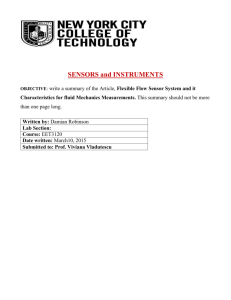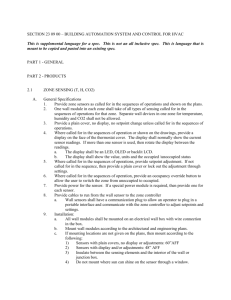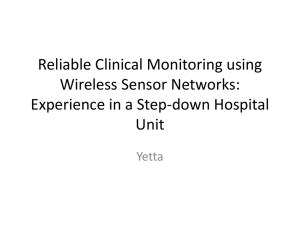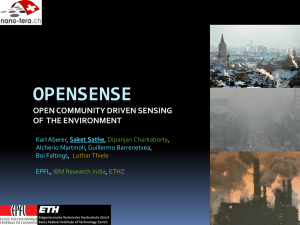Necessary Condition of Full View Coverage
advertisement
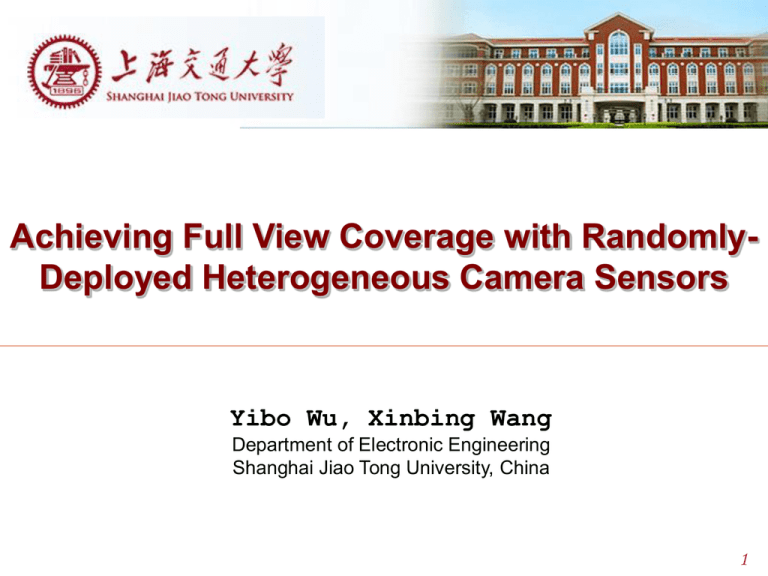
Achieving Full View Coverage with RandomlyDeployed Heterogeneous Camera Sensors Yibo Wu, Xinbing Wang Department of Electronic Engineering Shanghai Jiao Tong University, China 1 Outline Introduction Definition & Model Necessary Condition of Full View Coverage Sufficient Condition of Full View Coverage Evaluation & Conclusion 2 Introduction Design issues of coverage problems: Sensor Model disk or cone boolean or attenuated static or mobile homogeneous or heterogeneous Coverage Type area or barrier coverage 1- or k- coverage Deployment Method deterministic or random Target Area 2D, 3D or others Network Connectivity 1- or k- connectivity 3 Introduction [1] originated the analysis framework of asymptotic coverage, which supposed the sensor number goes to infinity (suitable for large-scale networks). Coverage of a square region is transferred to coverage of all the grid points in it. [1]S. Kumar, T. H. Lai and J. Balogh, “On k-coverage in a mostly sleeping sensor networks,” in Proc. of ACM MobiCom 04, Philadelphia, Pennsylvania, USA, Sept. 26-Oct. 1, 2004. 4 Introduction [2] found out the critical conditions for strong barrier coverage by applying bond percolation to the process of constructing barriers. A square is covered if it has a sensor. It's diagonal is thus called "open". Consecutive open edges form a barrier. [2]B. Liu, O. Dousse, J. Wang and A. Saipulla, “Strong barrier coverage of wireless sensor networks,” in Proc. of ACM MobiHoc 08, Hong Kong SAR, China, May 26-30, 2008. 5 Introduction For camera sensors, [3] proposed a new coverage type named "full-view coverage", aiming to guarantee the capture of the face image, and thus to raise the recognition probability. 1-coverage k-coverage: fault tolerance and image fusion full-view coverage: balanced distribution of cameras enables the capture of the stickman's face [3]Y. Wang and G. Cao, "On full-view coverage in camera sensor networks", in Proc. of IEEE INFOCOM 2011, Shanghai, China, April 10-15, 2011 6 Introduction Motivation of this work: As network construction is quite consuming, it's essential for operaters to know under what conditions (sensing parameters and sensor number) could the target area be full view covered ahead of actual deployment. The only result concerning the above question is in [3], but it's in a complicated form and therefore provides limited insights. Our objective is to find a "concise" critical condition for full view coverage. Namely, how sensing parameters and sensor number should be to achieve full view coverage in an area. 7 Outline Introduction Definition & Model Necessary Condition of Full View Coverage Sufficient Condition of Full View Coverage Evaluation & Conclusion 8 Defination & Model Sensor Model: Cameras in this work are static boolean cones with heterogeneous parameters. Important directions for sensor S and object P. sensor's orientation: where the lens are towards object's facing direction: where the object looks at object's viewed direction: which side of the object is captured by the camera 9 Defination & Model Description of heterogeneity Total n sensors are partitioned into u groups. Group y has cyn sensors, whose radius is ry and field of view is φy. Sensing area: Weighted summation of sy: Critical sensing area is defined to help evaluate the network. The overall requirements of heterogeneous sensors are thus generalised to one single parameter. 10 Defination & Model Target Area: The target area is a unit square. Deployment Method: Sensors are randomly and uniformly dropped in the target area. Coverage type: Full view coverage is formally defined below. Such coverage sets an upper bound for the angle between an object's facing direction and viewed direction. 11 Introduction Definition & Model Necessary Condition of Full View Coverage Sufficient Condition of Full View Coverage Evaluation & Conclusion 12 Necessary Condition of Full View Coverage Thinking that critical condition is hard to find directly, we begin with necessary condition, and obtain The proof can be decomposed into four steps A, B, C, D. 13 Necessary Condition of Full View Coverage Step A: coverage of whole region coverage of grid points We need the grid to be dense enough (m >= n log n) to make the transfer valid. 14 Necessary Condition of Full View Coverage Step B: find probability of covering one grid point P Construct a series of sectors as the left figure shows. To achieve full view coverage, each sector needs at least one sensor covering P. The impact of Tα is proved to be the same as the red sector showed in the figure. 15 Necessary Condition of Full View Coverage Step B: find the probability of covering one grid point P : point P fails to meet the necessary condition. After some calculation we have 16 Necessary Condition of Full View Coverage Step C: bound the probability of covering all grid points : one point doesn't meet the necessary condition : not all grid points meet the necessary condition Area of the red circle Area of the shaded region 17 Necessary Condition of Full View Coverage Step C: bound the probability of covering all grid points Then we have 18 Necessary Condition of Full View Coverage Step D: prove that For is the CSA for event where ξ>0 , we prove For where q>1, we prove The result will follow according to Definition 2. 19 Introduction Definition & Model Necessary Condition of Full View Coverage Sufficient Condition of Full View Coverage Evaluation & Conclusion 20 Sufficient Condition of Full View Coverage Similar as the situation in necessary condition, we have 21 Sufficient Condition of Full View Coverage Only difference: probability of covering one grid point The central angle of the sectors is θ, instead of 2θ in the necessary condition. 22 Introduction Definition & Model Necessary Condition of Full View Coverage Sufficient Condition of Full View Coverage Evaluation & Conclusion 23 Evaluation & Conclusion Decisive role of sensing area Requirements for network coverage lie on "sensing area" sc(n), rather than sensing radius or field of view. It's an inherent feature of random and uniform deployment, that coverage probability is propotional to the covering area of a sensor. Sensors with different sensing radius or field of view will behave similarly, if they own the same sensing area. 24 Evaluation & Conclusion Gap between necessary and sufficient conditions In necessary condition full view coverage is not guaranteed (orange direction is unsafe because β>θ). In sufficient condition there may be redundant sensors (orange sensor S can be removed since β<2θ). Is there an exact critical condition? 25 Evaluation & Conclusion Impact of θ and n when n is fixed. This result matches our intuition since cameras are distributed in a balanced form. When θ = 60o, we need 500 cameras whose sensing area is more than 1/10 of the target area to achieve full view coverage. It's so demanding that turning to deterministic deployment or barrier coverage is a desired step to make full view coverage practical and economical. 26 Thank you! 27


